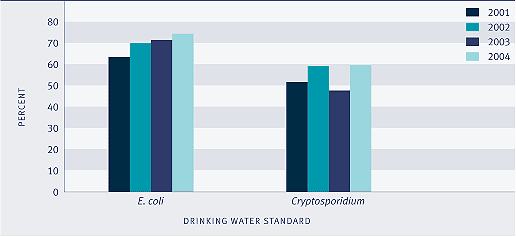Drinking water quality
Definition
The proportion of the total population whose drinking water complies with the 2000 Drinking Water Standards of New Zealand relating to E. coli and Cryptosporidium.
Relevance
Maintaining good drinking water quality is critical for human health and quality of life outcomes. The health risk to consumers from water-borne diseases in drinking water supplies comes from two main types of microorganisms: bacteria (such as faecal coliforms and E. coli) and parasites (such as Giardia and Cryptosporidium). Improvements in this indicator suggest less of the population is at risk of water-borne diseases and other microbiological contaminants.
Current level and trends
Most New Zealanders are supplied with drinking water that complies with the microbiological standards. However, many smaller communities are supplied with microbiologically non-compliant drinking water. The proportion of the total population whose drinking water, measured at the tap, complies with the 2000 Drinking Water Standards for E. coli has improved over the past four years, from 63 percent in 2001, to 70 percent in 2002, to 72 percent in 2003, and to 74 percent in 2004. Most water supplies serving large population areas are fully compliant with the 2000 standards. A significant reason for non-compliance is inadequate monitoring rather than the actual contamination of drinking water.
Compliance with the 2000 Drinking Water Standards for Cryptosporidium is assessed at the water treatment plant rather than at the tap. Cryptosporidium compliance rates have fluctuated over this period, from 52 percent in 2001, to 59 percent in 2002, to 48 percent in 2003, and to 60 percent in 2004. The drop in the compliance rate from 2002 to 2003 is largely due to non-compliance at the Waitakere plant, which has since been resolved.
Figure EN2.1 Proportion of the total population served with water that meets the 2000 Drinking Water Standards, 2001–2004

Source: Water Information New Zealand Database, May 2006
Regional differences
Groundwater sources supply drinking water for approximately 40 percent of the New Zealand population; about 60 percent of people are supplied from surface water. Most water in catchment headwaters is of good quality. Lower down the catchment, where farming and intensive land use occurs (eg intensive livestock farming), water quality deteriorates. Problems with the quality of some groundwater sources have also been identified.
There is considerable regional variation in the population served with drinking water that is fully compliant with the 2000 Drinking Water Standards for E. coli and Cryptosporidium. In 2004, only 4 percent of the population in the Marlborough region was served with drinking water that fully complied with the 2000 Drinking Water Standards for E. coli. The West Coast and Tasman regions also had low compliance rates, with 35 percent and 43 percent of the population respectively supplied with drinking water that was fully compliant. Compliance was highest in the Nelson region (95 percent), followed by the Auckland and Wellington regions (90 percent each).
In 2004, none of the population in the Marlborough region was supplied with drinking water that fully met the 2000 Drinking Water Standards for Cryptosporidium. Only 1 percent of the population in the Northland region and the West Coast region was supplied with fully-compliant water. Compliance was highest in the Nelson region (95 percent), followed by the Auckland region (87 percent) and the Wellington region (75 percent).
Where drinking water quality is affected, the agricultural sector is seen as the most significant source of contamination.79
International comparison
Overall, the quality of New Zealand's water is comparable with other developed countries. New Zealand's water supplies are free of many of the pathogens that result in sickness and death in other countries. However, the incidence of Giardia infection in New Zealand is 85 per 100,000 people, which is considered high compared to the reported rates for other western countries.80 The contribution of contaminated drinking water to the incidence of giardiasis is not known.
|

